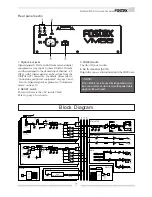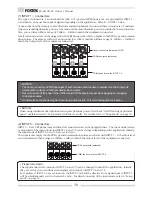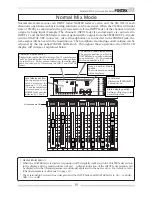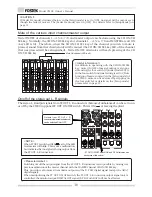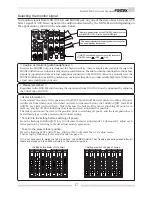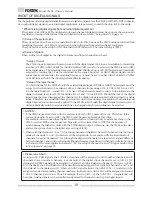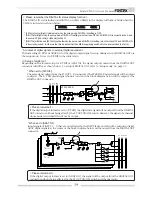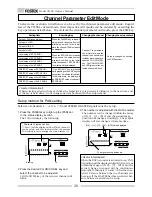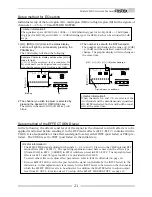
6
Model VM88 Owner’s Manual
(A) Character display section
Names of the scene memory or various edit modes
are displayed.
(B) CHANNEL fader display section
In channel parameter edit mode, the INPUT fader
position of the selected channel is displayed in
units of 00 ~ 99. Nothing will be displayed in the
initial state and the normal mix mode.
(C) MASTER fader display section
The MASTER fader position is displayed in units
00 ~ 99.
(D) Digital in status display section
This displays the [DIGITAL IN] setting in the setup
mode, and the external digital input signal status.
For details, refer to [IN/OUT of digital signals] in
“Normal mix mode” on page 18.
(E) Scene number display
The current scene number is displayed here.
Refer to [Scene memory mode] on page 30 for
details.
(F) LED level meter display section
The output level of the STEREO BUSS is displayed
here. When ST OUT ON/OFF is switched to OFF
( ), all LEDs will blink to indicate that no signal is
output from the ST OUT L, R connectors.
This level meter has a peak hold function, which
is adjustable in the setup mode. The initial state
peak hold time is set to 1.0 sec. For details, refer
to “Setup mode” on page 33.
(G) Status indicator
Using the channel parameter edit mode explained
later, what is currently setup can be confirmed
by the dot display. Items to be set can be selected
with the PAN/EQ key or the EFF/AUX key. Refer
to [Channel parameter edit mode] on page 20 for
details.
(H) LCD level meter
In normal mix mode, this indicates channels 1 ~ 8
input levels and the stereo buss level. In the
various edit modes, the setup status will be
displayed. The peak hold function is not provided
in the LCD level meter.
30. TRIM knob
These knobs are for adjusting the input gain to match
the sound source connected to INPUT 1 ~ 8. These
can be adjusted within the range of -50dBu ~ -10dBu
for MIC INPUT 1 ~ 4, -30dBu ~ +10dBu for LINE INPUT
1 ~ 4 and -40dBu ~ +4dBu for INPUT 5 ~ 8.
31. Input jack 5 ~ 8
Line level sound sources can be connected to channels
5 ~ 8 input jacks (TRS phone jacks). In the initial
setup, the input mode of INPUT 5-6 and INPUT 7-8
are set to stereo so that stereo output sound sources
can be connected.
The input mode can also be set for monaural by the
setup mode. Trim is adjustable to match the output
of the sound source that is connected (Adjusting
range: -40dBu ~ +4dBu). To setup of the input mode,
refer to “Setup mode” on page 33.
32. Insert jack 1 ~ 4
These jacks are used when using a compressor/limiter
on mic sound sources at inputs 1 ~ 4. For details,
refer to “Connecting peripheral equipment” on page
9.
can be setup. Refer to [Channel parameter edit mode]
on page 20 for details.
25. Fader adjust key
This key warns by blinking if a fader position drifts
or sound volume is accidentally changed at switch
ON of power or at recall of the scene memory.
Use this key to enter the fader adjust mode to manu-
ally adjust the fader position. Refer to [Fader adjust
mode] on page 31 for details.
26. Channel On/Channel Select key
The channel to be edited can be selected while in the
channel parameter edit mode. In other modes, chan-
nel ON/OFF is possible. Refer to [Normal mix mode]
on page 18 and [Channel parameter edit mode] on
page 20 for details.
27. Level adjust key
This key will blink together with of the FADER AD-
JUST key. The level adjust mode is entered when
this key is pressed so the sound level can be matched
to the present fader position. Refer to [Level adjust
mode] on page 31 for details.
28. Contrast adjusting knob
Adjust he LCD display contrast with this knob.
Rotating this knob clockwise increases the contrast.
29. Display/status/meter section







